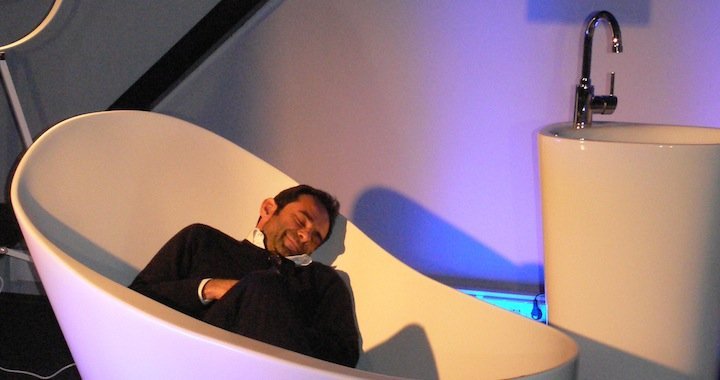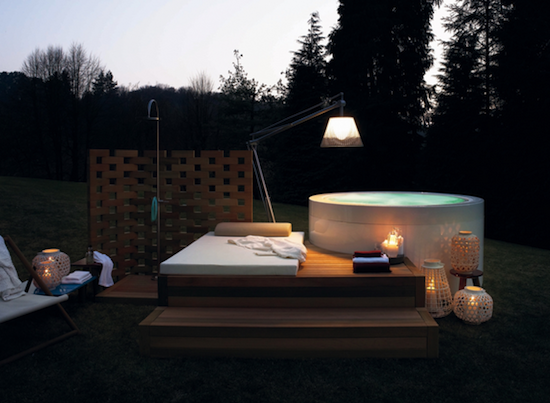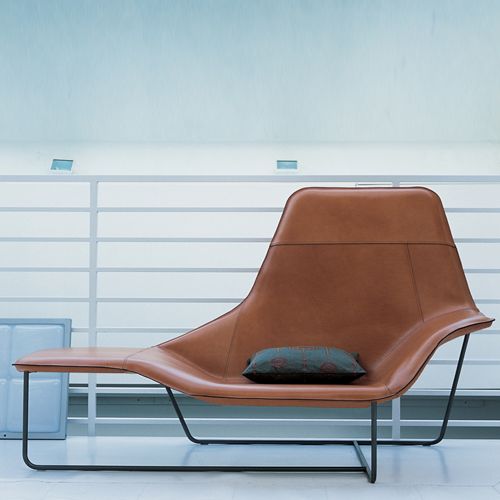
Roberto Palomba, the Spy
For almost twenty years now, designs made by Palomba Serafini Associati are still continuously coming off of the factory's conveyor belt. Born in the city of Cagliari on the island of Sardinia, Roberto Palomba (1963) has been called the most copied designer in the world (in individual fields of design).
At the root of the Palomba Serafini Associati design company's success are its abilities to clearly make out a vision of development for today's society, and to understand the needs of its customers. With a solid knowledge of the historical and cultural aspects of design, and by always reaching for the highest standards in quality, the company successfully finds the middle-ground between the past and the future in its projects.
The design duo is currently working on several important projects world-wide, such as the architecture and interior of living spaces, and yacht design. Alongside the awards that they have received in previous years – Compasso D’Oro, Red Dot Award, Design Plus Award, Product Innovation Award, German Design Award and the Elle Decoration International Design Award – this year saw the following additions: Selection ADI Design Index (Italy), Green Good Design Award (USA) and the Honourable Mention Red Dot Award (Germany).
Roberto Palomba was recently in Riga to give his lecture, “My Life as a Designer”, at the Art Academy of Latvia. Arterritory.com took the opportunity to meet with the designer.
Your success is rooted in the ability to understand and predict the needs of consumers. In a certain sense, doesn't this fall under the field of trend watching?
I do not study trends; I study people. I don't follow trends – I create them. That is my company's job. We try to understand society, its needs, what it likes, what it loves, what it fears... Also, in the same way, we want to know what are people's ambitions and values – do they want an apartment in a skyscraper, or a small cottage in the country? We try to spy on them in all of these aspects. Yes, we are like spies. I am constantly observing people. I look and look, and listen and listen... more than I actually speak aloud myself.
What, in your opinion, would be five needs of the design consumer in the coming year?
We currently find ourselves in a situation in which the market is quiet. It's like we are frozen in ice and waiting. One thing is clear – the European sun is slowly setting, and the sun of newly developing countries is rising. But it is not yet clear what that sun will be like.
Nevertheless, there is a completely opposing scale of needs and wants among the markets of various countries. North America, China, the Middle East – each one wants something entirely different, and entirely different from what it is that Europe wants. There still are countries in which luxury prevails, but as a whole, what is necessary for people around the world is emotions. Finding out what these are requires empathy from the designers.

Minipool. Kos. 2012
Do you believe in inspiration? Or do you just concentrate on people's actions and needs?
The people themselves inspire me. If you are a creative person, for whom making something new is a daily thing, then you must be able to gain inspiration from anything – from color, from form... To find inspiration for design, the designer must live almost without a skin – you must be “permeable”, completely open. Of course, this is not always easy.
Through being well-versed in the history of design, you shape the future of design. What are the rules, and the best instances of design, in this history?
The structure of classical Scandinavian design is what we base our daily work on. We try to simplify things without sacrificing their poesy. Masters of classic Danish design, such as Hans Wegner and Paul Kjærholm, or Alvar Aalto from Finland, based their design on social understanding. The same as the American designers of the 1950s, with Warren Platner at the front. The design of that time was created for society. Designers were supposedly providing design services, but in a cultural way – with a certain dose of emotions. Platner's and Harry Bertoia's chairs are still perfect for today. Those weren't simply chairs for sitting on – they evoked emotions.
What, then, is the formula for having a certain design in constant production for decades?
Design is a mirror of society which reflects what is most important to society. As soon as some priorities disappear, the design also looses its value – and it is thrown into the garbage. But as a whole, simple and emotionally saturated things have a much longer life.

Lama. Zanotta. 2005
We are living in a time in which the world is experiencing radical changes. Many things are being redefined. Will there also be a new definition for design and architecture?
Yes, no... who knows? Who needs to know?
Before, designers followed design, musicians followed music... today there no longer is design, music or literature just on its own, but there still are designers, musicians and writers who still express their individual culture – their personality.
Before, there was the baroque, there was minimalism. Today, it's the super-baroque, the super-minimalistic, the digital, the radical... Everything is somehow superfluous. And there is no longer one design – there are several designers.
Is there one unifying idea that permeates all of your works of a certain time period?
That would be like asking – How do I drive a car? I just do. I don't think – Now I'll switch that on, now I'll turn that so... I simply drive the car.
I live with design, I have clients the world over, and twenty-seven companies work with me. When I understood that I no longer have to think, but just do – then I finally understood that I am a designer. It happens somehow automatically, really just like driving a car – enjoying the process, listening to music, changing speeds, without filing things in your head. That's what it means to be a professional.
How important is it for you to be original?
I must always be 100% original!
What do you think about the fact that your designs are being copied?
He who follows somebody will never come out ahead. It's a simple and practically physical law.
But how would you feel if your house was robbed, if your personal and beloved things were stolen? It's the same feeling when design – that you have created – is stolen. But the person who has stolen it is, and will always be, just a thief. A stealer of design is someone who couldn't design anything original himself. And what can I say? I feel sorry for him!
The more that you're copied, the closer you are to the top. I can say that up until now, in terms of bathroom design, I am the most copied designer in the world – so, that must mean that I'm the best!
What would you teach new designers?
Express yourself, don't repress yourself! If a person controls himself while he is young, then he is literally killing himself. Never do this! Trust yourself (the only person whom I trust is myself), follow yourself, don't give in to compromise, and fight like an animal against what it is that is repressing you.